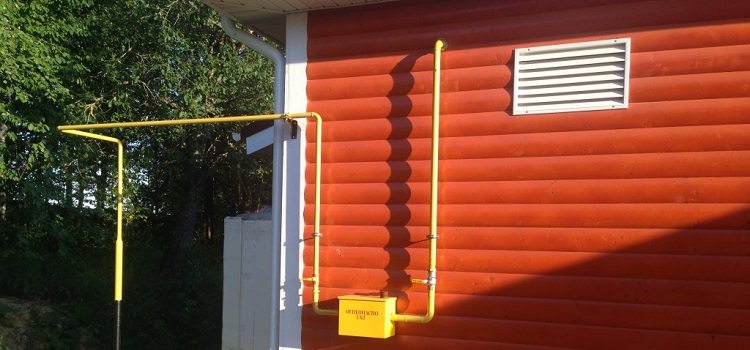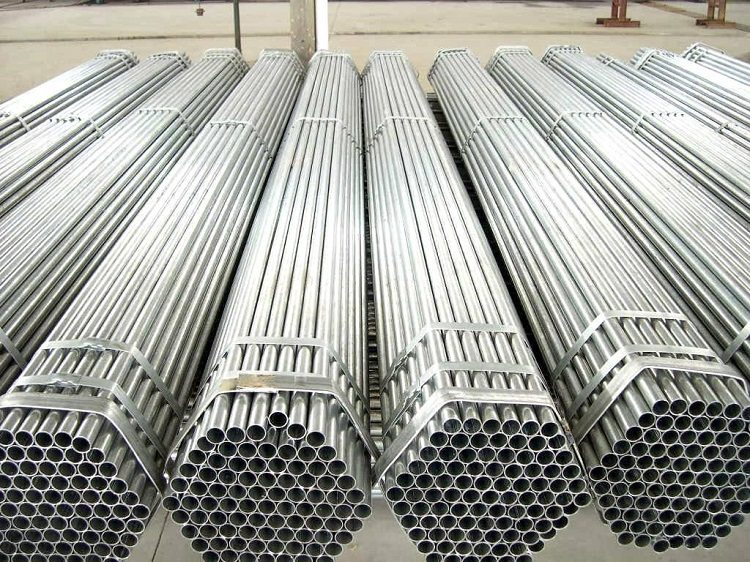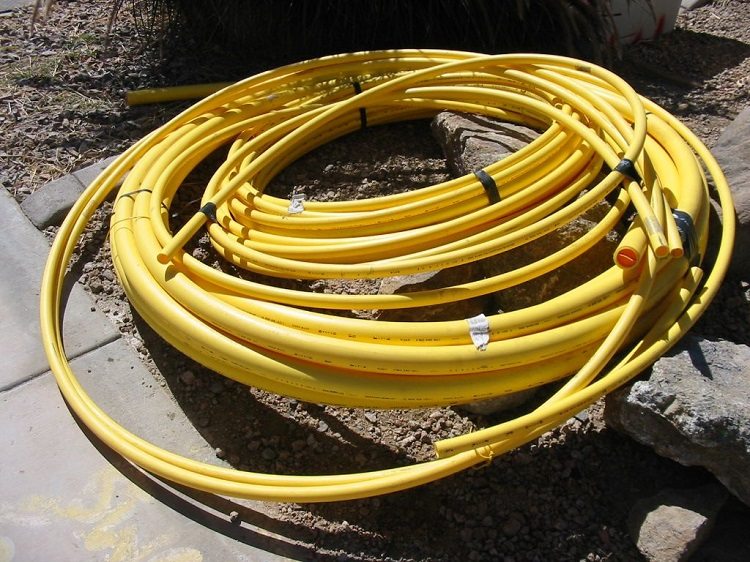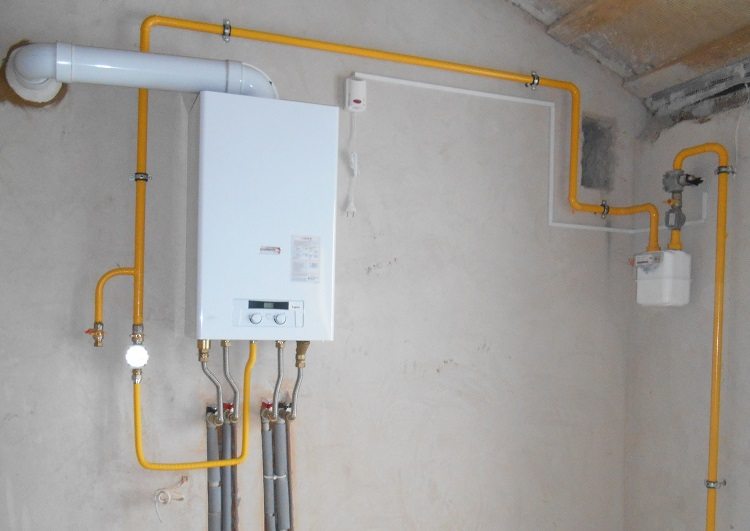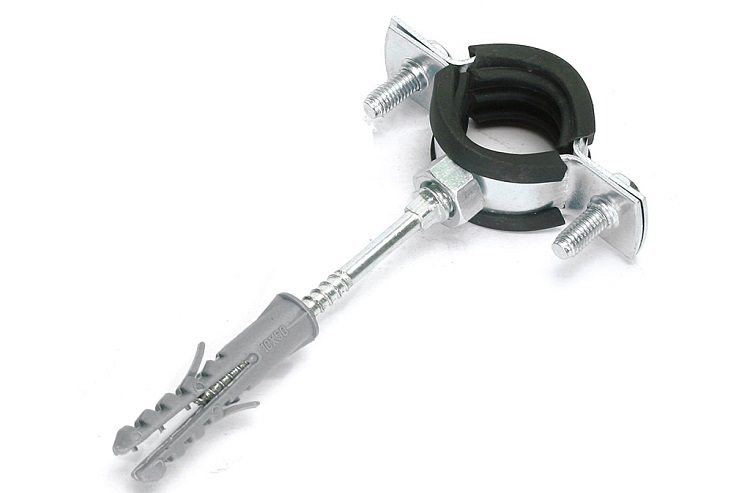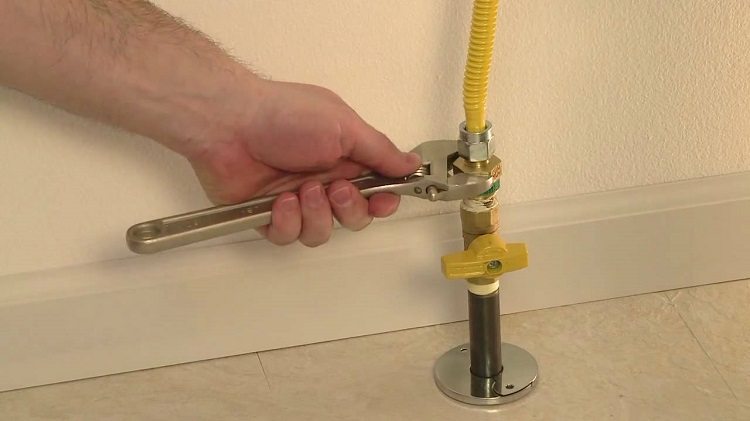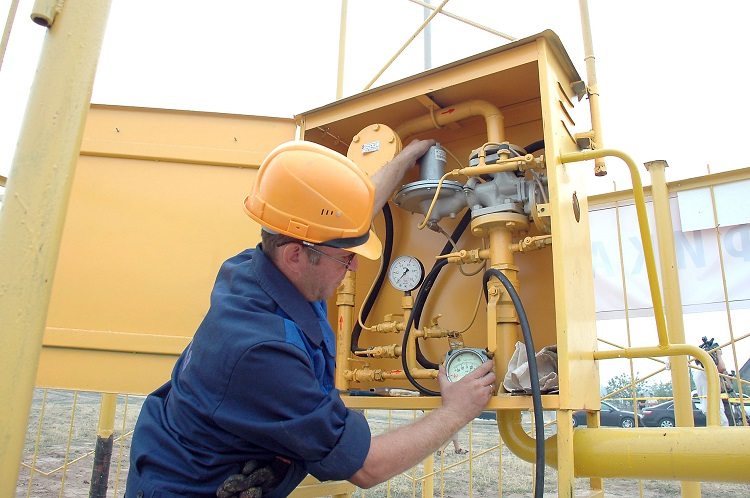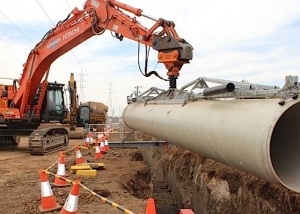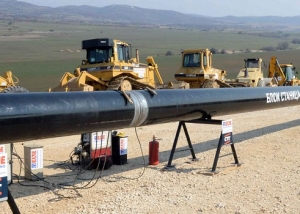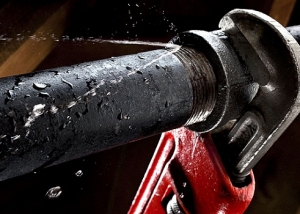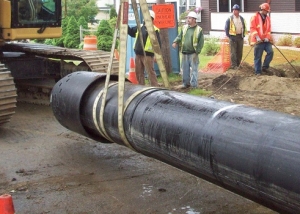To establish a pipeline for gas supply to an apartment or a plot is a technically difficult task. The household gas used for heating and cooking is very explosive. Any mistake made during the gasification process can cause serious damage to the property and health of residents. Therefore, when laying a gas pipeline, each stage is important: from the choice of gas pipes to their installation.
Content
The choice of pipes for the gas pipeline
For laying gas pipelines in an apartment and a private house, the most popular are metal elements. Steel pipes for gas pipelines are resistant to internal pressure, they provide complete tightness, which eliminates gas leaks.
Depending on the pressure in the gas pipe in the apartment, a variety of pipes for laying the gas main is determined. There are gas pipelines with the following conditions:
- low pressure - not more than 0.05 kgf / cm2;
- average pressure - from 0.05 to 3.0 kgf / cm2;
- high pressure - from 3 to 6 kgf / cm2.
Thin-walled metal pipes are used only for gas pipelines in which low pressure is observed. Due to the extreme lightness of the material, thin-walled steel pipes can be involved in laying pipelines with a complex structure. In addition, such a pipe is quite flexible - it is possible to bend steel thin-walled pipes (at a small angle) without pipe bender. Thin-walled metal pipe is easy to solder. Threaded steel pipes can be interconnected using fittings, and bell-shaped thin-walled products are connected only with a sealant (hemp fiber).
If it is necessary that the gas pipeline withstands high pressure, more massive pipes should be used. For the construction of structures with increased requirements for strength, steel seamless pipes are used. The best characteristics are cold-deformed steel pipes. But the process welding seamless products are more problematic than soldering lightweight thin-walled pipes. More optimal option in terms of performance than steel thick-walled pipes are copper products. Together with an identical degree of reliability, they have a much lighter weight, but are notable for their high cost.
Helpful advice! A thin-walled steel pipe is characterized by high thermal conductivity, which leads to condensation on the pipe surface. To prevent acceleration of corrosion processes on the walls, after installation, it is necessary to apply several protective layers of oil paint on the pipes.
Plastic pipes are used to lay the pipeline into the ground. Such gas pipes are flexible, ductile and inexpensive. For underground structures, polypropylene and polyethylene products are recommended. They are often used for gasification of private houses. When laying a gas pipeline in the country, polyethylene pipes (low pressure) are purchased. As a rule, they are black with a yellow marking. Pipes made of high pressure polyethylene are never used as gas pipes.
For distributing pipes in the house, the use of hoses made of vulcanized rubber with textile reinforcement is allowed. But they do not withstand high pressure, and are most often used when connecting devices to a balloon gas source or to a geyser system.
But the use of plastic pipes is prohibited in some cases:
- if the gas pipeline will be laid in areas with atmospheric pressure below 45 degrees;
- in areas with seismic activity above 6 points;
- if the pressure in the gas zone is high;
- when laying a gas pipeline inside any premises, tunnels and collectors.
In all these situations HDPE gas pipe will not be able to fully perform their functions. Therefore, in these cases only steel thin-walled or seamless pipelines can be used.
Norms for gas pipes in the apartment
Before you begin to develop a plan for installing a gas pipeline in an apartment or a house, it should be clarified under what circumstances it will be used. For example, in the kitchen, as an indispensable tool for the operation of a gas stove, column or in a boiler room to provide heat to the house. The gas pipelines in the apartment are subject to special requirements.
Compliance with these operating and installation standards for gas pipes in the kitchen guarantees the safety and comfort of using the gas pipeline:
- Installation of gas pipes in living rooms, as well as laying a gas pipeline in ventilation shafts, is not allowed.
- The gas thin-walled pipe should not intersect with window and doorways.
- It is forbidden to lay pipes in hard-to-reach places, for example, behind decorative wall sheathing (with the exception of structures that are easy to dismantle). The gas system should always have quick access in case of breakage.
- The distance of the pipe from the floor should not be less than 2 m.
- The length of flexible communication segments, if a thin-walled pipe is used, cannot exceed 3 m. The density of the connection of network fragments is also important.
- Installation of gas communications is possible in rooms with a ceiling height of at least 2.2 m. The room must be well ventilated.
- Ventilation in the kitchen, if a gas pipeline is laid there, cannot be adjacent to rooms and other living quarters.
- The ceiling and walls near the gas system are coated with a layer of non-flammable plaster. If the wall in the kitchen is not plastered, it is isolated from gas lines (especially from the gas column) with a sheet of metal 3 mm thick.
Some rules also apply to the installation of pipes for a geyser in an apartment. Geysers are mounted with an exhaust pipe - a chimney. A flexible aluminum goof tube cannot be used as a chimney, the installation of the exhaust pipes of the column is carried out only with the help of steel or galvanized products.
Helpful advice! Any heating appliances, including gas stoves, must be equipped with fuses. They are needed so that the gas supply is forcibly shut off when the fire accidentally goes out.
The installation of thin-walled gas pipes in the kitchen also has features:
- Before starting work, make sure that the main gas valve is shut off;
- if produced gas pipe transfer in the kitchen, the gas pipeline is purged. This allows you to get rid of gas residues in the system;
- It is worth taking care of fixing the gas pipe to the wall. Mounting is done using special clamps and brackets. What kind of fastener will be used depends on the diameter of the pipes and their length;
- if electric cables pass near the pipes of the gas pipeline, then the distance between these communications should be at least 25 cm. And the distance between the gas system and the electric switchboard should be from 50 cm;
- it is undesirable to place cooling equipment in the kitchen near the planned gas pipeline system: refrigerators, freezers. The presence of a gas pipe behind the refrigerator can cause overheating of its radiator, and, as a result, equipment malfunction;
- It is also not recommended to mount thin-walled steel gas pipes too close to heating appliances and directly to the gas stove, behind the wall of the gas column;
- gas pipes in the kitchen cannot be laid on the floor, under sinks, near dishwashers. Mask the gas pipe can be other, safe methods;
- repair work is preferably carried out without the use of artificial lighting, in a constantly ventilated room.
The specified standards are relevant both for existing gas systems and for gas pipes that are installed or transported only.
Laying gas pipes in a private house: basic standards
Gasification of private homes should begin with a notification to the local gas service of upcoming repairs. The relevant organizations are required to provide a technical condition that will determine the procedure for laying the gas pipeline. Upon completion of technical approval, an individual gasification project for the site is developed. An order for permission to lay a gas pipeline should also be issued by representatives of the Automobile Inspectorate (STSI).
If a certain number of houses in the locality are already gasified and only the connection of gas pipes in one section to the main system is required, then the service should provide information about the working gas pressure in the mains. From what pressure is maintained in the main pipes, the choice of pipes for gas in the house will depend.
Depending on which gas source was chosen to supply the site, the gas supply system can be autonomous or central. Gas pipelines for private homes are divided into land and underground. The installation and installation of gas communications on the site is quite simple and requires much less time than directly obtaining permission to implement a gasification project.
The gas pipeline has the following steps:
- laying a line of gas pipes from the distribution area to the house (if necessary, done gas line insert);
- entering the pipeline into the house through a cabinet with a pressure reducer;
- installation of piping in rooms (boiler room, kitchen);
- commissioning of equipment, commissioning of the system, checking the performance of the gas stove and column (usually this stage is carried out in the presence of technical inspectors).
General requirements for the structure of the gas pipeline in a private house include the same points as the norms for laying gas pipes in the apartment and in the kitchen. The installation work during the gas pipeline to the house must comply with the following rules:
- The depth of the gas pipes in the area is not less than 1.25 m and not more than 1.75-2 m.
- The pipeline entry into the structure has a shallower depth: from 0.75 to 1-1.25 m.
- If it is planned to transport liquefied gas, the gas pipeline should be laid to a depth below the freezing of the soil (the regional climatic features are taken into account). The input of the pipe into the house is then carried out through the foundation.
- If a gas boiler is installed in a private house, the area of the room per unit of equipment is 7.5 m2. Accordingly, two geysers or boilers require an area of 15 m2.
- Boilers and columns with power up to 60 kW are installed in rooms in which the height from floor to ceiling is at least 2.4 m.
Helpful advice! Before laying gas pipes into the ground, steel structures are insulated with anti-corrosion materials. For this, a flexible polymer-bitumen tape is used. Insulation of the inside of the pipe is not required since natural gas does not contribute to corrosion.
If you need to install an autonomous gas source in the country or on the site of a private house, you should pay attention to specific safety standards. They will ensure the normal operation of the stove, column and heating system.
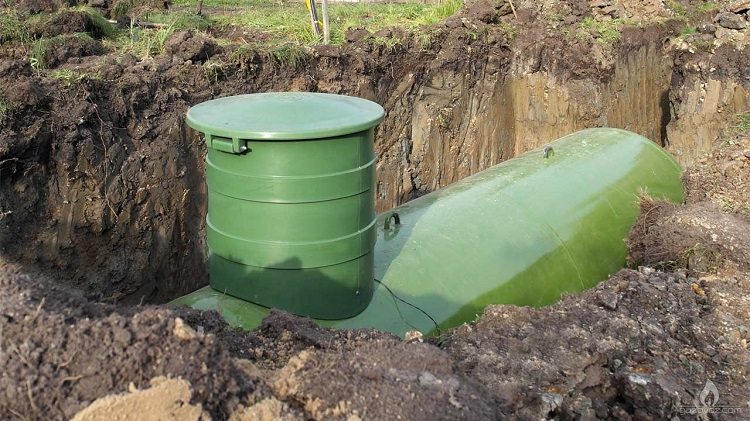
Installation of a tank for liquefied gas on the site is carried out in accordance with the requirements of SNiP
The distance from the reservoir with liquefied gas underground to the well should not be less than 15 m. The foundation pit is excavated for capacity at a distance of at least 10 m from the house. Outbuildings can be no closer than 7-8 meters from the store. The volume of the tank will depend on the number of gas consumption devices (stoves, columns) and the total heating area. Most often, tanks with a volume of 2.7 m3 to 6.4 m3 are used on the farm. Models of tanks with a volume of 6.4 m3 are optimal for supplying gas to large buildings: the total area of the heated premises in the house can be up to 300 m2.
Requirements and recommendations for laying gas pipes underground
Relative to the ground laying of gas pipes, the installation of underground gas pipeline structures has a rather high cost. However, this does not reduce the demand for underground gas pipelines. They are less dangerous, better protected from damage and do not spoil the aesthetic appearance of the site. For the laying of such highways, there are also rules and conditions:
- if the analysis of soil corrosion in the area gave a positive result, it is better not to lay the pipeline underground. But the presence of high-voltage wires near, on the contrary, is a weighty argument in favor of the underground structure, but then the pipes are covered with insulation;
- when laying a polyethylene gas pipeline, products of increased strength (PE-80, PE-100) are used. Flexible pipe PE-80 will be able to safely service systems whose working pressure does not exceed 0.6 MPa. For systems where the pressure is from 0.6 MPa to 1.2 MPa, it is better to use pipes and connecting elements PE-100 or steel pipes. The depth of laying underground will be at least 1.0 m;
- it is allowed to use reinforced polyethylene pipes and connection elements between them when laying gas pipelines, the pressure in which will be more than 0.6 MPa. The permissible laying depth underground will also begin with 1.0 m;
- on lands intended for arable land, as well as on plentifully irrigated areas, the initial depth of the gas pipeline will be 1.2 m.
Knowing these requirements for high-quality laying of the gas pipeline underground will help to correctly install gas pipes with your own hands, as well as to monitor the actions of workers in order to avoid mistakes that entail negative consequences.
